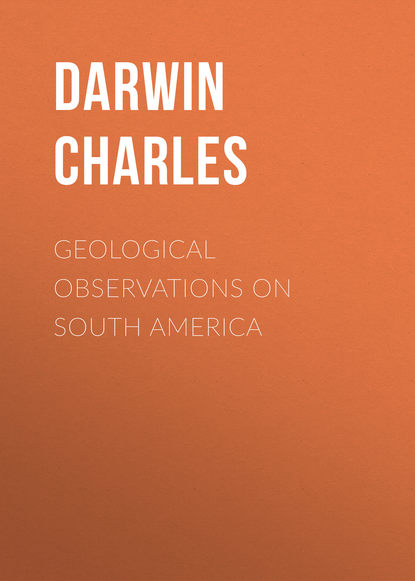
Полная версия
Geological Observations on South America
1. Buccinanops globulosum, d'Orbigny.
2. Olivancillaria auricularia, d'Orbigny.
3. Venus flexuosa, Lam.
4. Cytheraea (imperfect).
5. Mactra Isabellei, d'Orbigny.
6. Ostrea pulchella, d'Orbigny.
Besides these, Sir W. Parish procured ("Buenos Ayres" etc. by Sir W. Parish page 168.) (as named by Mr. G.B. Sowerby) the following shells: —
7. Voluta colocynthis.
8. Voluta angulata.
9. Buccinum (not spec.?).
All these species (with, perhaps, the exception of the last) are recent, and live on the South American coast. These shell-beds extend from one league to six leagues from the Plata, and must lie many feet above its level. I heard, also, of beds of shells on the Somborombon, and on the Rio Salado, at which latter place, as M. d'Orbigny informs me, the Mactra Isabellei and Venus sinuosa are found.
During the elevation of the Provinces of La Plata, the waters of the ancient estuary have but little affected (with the exception of the sand- hills on the banks of the Parana and Uruguay) the outline of the land. M. Parchappe, however, has described groups of sand dunes scattered over the wide extent of the Pampas southward of Buenos Ayres (D'Orbigny "Voyage Geolog." page 44.), which M. d'Orbigny attributes with much probability to the action of the sea, before the plains were raised above its level. (Before proceeding to the districts southward of La Plata, it may be worth while just to state, that there is some evidence that the coast of Brazil has participated in a small amount of elevation. Mr. Burchell informs me, that he collected at Santos (latitude 24 degrees S.) oyster-shells, apparently recent, some miles from the shore, and quite above the tidal action. Westward of Rio de Janeiro, Captain Elliot is asserted (see Harlan "Med. and Phys. Res." page 35 and Dr. Meigs in "Transactions of the American Philosophical Society"), to have found human bones, encrusted with sea-shells, between fifteen and twenty feet above the level of the sea. Between Rio de Janeiro and Cape Frio I crossed sandy tracts abounding with sea-shells, at a distance of a league from the coast; but whether these tracts have been formed by upheaval, or through the mere accumulation of drift sand, I am not prepared to assert. At Bahia (latitude 13 degrees S.), in some parts near the coast, there are traces of sea-action at the height of about twenty feet above its present level; there are also, in many parts, remnants of beds of sandstone and conglomerate with numerous recent shells, raised a little above the sea-level. I may add, that at the head of Bahia Bay there is a formation, about forty feet in thickness, containing tertiary shells apparently of fresh-water origin, now washed by the sea and encrusted with Balini; this appears to indicate a small amount of subsidence subsequent to its deposition. At Pernambuco (latitude 8 degrees S.), in the alluvial or tertiary cliffs, surrounding the low land on which the city stands, I looked in vain for organic remains, or other evidence of changes in level.)
SOUTHWARD OF THE PLATA.
The coast as far as Bahia Blanca (in latitude 39 degrees S.) is formed either of a horizontal range of cliffs, or of immense accumulations of sand-dunes. Within Bahia Blanca, a small piece of tableland, about twenty feet above high-water mark, called Punta Alta, is formed of strata of cemented gravel and of red earthy mud, abounding with shells (with others lying loose on the surface), and the bones of extinct mammifers. These shells, twenty in number, together with a Balanus and two corals, are all recent species, still inhabiting the neighbouring seas. They will be enumerated in the Fourth Chapter, when describing the Pampean formation; five of them are identical with the upraised ones from near Buenos Ayres. The northern shore of Bahia Blanca is, in main part, formed of immense sand-dunes, resting on gravel with recent shells, and ranging in lines parallel to the shore. These ranges are separated from each other by flat spaces, composed of stiff impure red clay, in which, at the distance of about two miles from the coast, I found by digging a few minute fragments of sea-shells. The sand-dunes extend several miles inland, and stand on a plain, which slopes up to a height of between one hundred and two hundred feet. Numerous, small, well-rounded pebbles of pumice lie scattered both on the plain and sand-hillocks: at Monte Hermoso, on the flat summit of a cliff, I found many of them at a height of 120 feet (angular measurement) above the level of the sea. These pumice pebbles, no doubt, were originally brought down from the Cordillera by the rivers which cross the continent, in the same way as the river Negro anciently brought down, and still brings down, pumice, and as the river Chupat brings down scoriae: when once delivered at the mouth of a river, they would naturally have travelled along the coasts, and been cast up during the elevation of the land, at different heights. The origin of the argillaceous flats, which separate the parallel ranges of sand-dunes, seems due to the tides here having a tendency (as I believe they have on most shoal, protected coasts) to throw up a bar parallel to the shore, and at some distance from it; this bar gradually becomes larger, affording a base for the accumulation of sand- dunes, and the shallow space within then becomes silted up with mud. The repetition of this process, without any elevation of the land, would form a level plain traversed by parallel lines of sand-hillocks; during a slow elevation of the land, the hillocks would rest on a gently inclined surface, like that on the northern shore of Bahia Blanca. I did not observe any shells in this neighbourhood at a greater height than twenty feet; and therefore the age of the sea-drifted pebbles of pumice, now standing at the height of 120 feet, must remain uncertain.
The main plain surrounding Bahia Blanca I estimated at from two hundred to three hundred feet; it insensibly rises towards the distant Sierra Ventana. There are in this neighbourhood some other and lower plains, but they do not abut one at the foot of the other, in the manner hereafter to be described, so characteristic of Patagonia. The plain on which the settlement stands is crossed by many low sand-dunes, abounding with the minute shells of the Paludestrina australis, d'Orbigny, which now lives in the bay. This low plain is bounded to the south, at the Cabeza del Buey, by the cliff-formed margin of a wide plain of the Pampean formation, which I estimated at sixty feet in height. On the summit of this cliff there is a range of high sand-dunes extending several miles in an east and west line.
Southward of Bahia Blanca, the river Colorado flows between two plains, apparently from thirty to forty feet in height. Of these plains, the southern one slopes up to the foot of the great sandstone plateau of the Rio Negro; and the northern one against an escarpment of the Pampean deposit; so that the Colorado flows in a valley fifty miles in width, between the upper escarpments. I state this, because on the low plain at the foot of the northern escarpment, I crossed an immense accumulation of high sand-dunes, estimated by the Gauchos at no less than eight miles in breadth. These dunes range westward from the coast, which is twenty miles distant, to far inland, in lines parallel to the valley; they are separated from each other by argillaceous flats, precisely like those on the northern shore of Bahia Blanca. At present there is no source whence this immense accumulation of sand could proceed; but if, as I believe, the upper escarpments once formed the shores of an estuary, in that case the sandstone formation of the river Negro would have afforded an inexhaustible supply of sand, which would naturally have accumulated on the northern shore, as on every part of the coast open to the south winds between Bahia Blanca and Buenos Ayres.
At San Blas (40 degrees 40' S.) a little south of the mouth of the Colorado, M. d'Orbigny found fourteen species of existing shells (six of them identical with those from Bahia Blanca), embedded in their natural positions. ("Voyage" etc. page 54.) From the zone of depth which these shells are known to inhabit, they must have been uplifted thirty-two feet. He also found, at from fifteen to twenty feet above this bed, the remains of an ancient beach.
Ten miles southward, but 120 miles to the west, at Port S. Antonio, the Officers employed on the Survey assured me that they saw many old sea- shells strewed on the surface of the ground, similar to those found on other parts of the coast of Patagonia. At San Josef, ninety miles south in nearly the same longitude, I found, above the gravel, which caps an old tertiary formation, an irregular bed and hillock of sand, several feet in thickness, abounding with shells of Patella deaurita, Mytilus Magellanicus, the latter retaining much of its colour; Fusus Magellanicus (and a variety of the same), and a large Balanus (probably B. Tulipa), all now found on this coast: I estimated this bed at from eighty to one hundred feet above the level of the sea. To the westward of this bay, there is a plain estimated at between two hundred and three hundred feet in height: this plain seems, from many measurements, to be a continuation of the sandstone platform of the river Negro. The next place southward, where I landed, was at Port Desire, 340 miles distant; but from the intermediate districts I received, through the kindness of the Officers of the Survey, especially from Lieutenant Stokes and Mr. King, many specimens and sketches, quite sufficient to show the general uniformity of the whole line of coast. I may here state, that the whole of Patagonia consists of a tertiary formation, resting on and sometimes surrounding hills of porphyry and quartz: the surface is worn into many wide valleys and into level step-formed plains, rising one above another, all capped by irregular beds of gravel, chiefly composed of porphyritic rocks. This gravel formation will be separately described at the end of the chapter.
My object in giving the following measurements of the plains, as taken by the Officers of the Survey, is, as will hereafter be seen, to show the remarkable equability of the recent elevatory movements. Round the southern parts of Nuevo Gulf, as far as the River Chupat (seventy miles southward of San Josef), there appear to be several plains, of which the best defined are here represented.
(In the following Diagrams: 1. Baseline is Level of sea. 2. Scale is 1/20 of inch to 100 feet vertical. 3. Height is shown in feet thus: An. M. always stands for angular or trigonometrical measurement. Ba. M. always stands for barometrical measurement. Est. always stands for estimation by the Officers of the Survey.
DIAGRAM 1. SECTION OF STEP-FORMED PLAINS SOUTH OF NUEVO GULF.
From East (sea level) to West (high):
Terrace 1. 80 Est.
Terrace 2. 200-220 An. M.
Terrace 3. 350 An. M.)
The upper plain is here well defined (called Table Hills); its edge forms a cliff or line of escarpment many miles in length, projecting over a lower plain. The lowest plain corresponds with that at San Josef with the recent shells on its surface. Between this lowest and the uppermost plain, there is probably more than one step-formed terrace: several measurements show the existence of the intermediate one of the height given in Diagram 1.
(DIAGRAM 2. SECTION OF PLAINS IN THE BAY OF ST. GEORGE.
From East (sea level) to West (high):
Terrace 1. 250 An. M.
Terrace 2. 330 An. M.
Terrace 3. 580 An. M.
Terraces 4, 5 and 6 not measured.
Terrace 7. 1,200 Est.)
Near the north headland of the great Bay of St. George (100 miles south of the Chupat), two well-marked plains of 250 and 330 feet were measured: these are said to sweep round a great part of the Bay. At its south headland, 120 miles distant from the north headland, the 250 feet plain was again measured. In the middle of the bay, a higher plain was found at two neighbouring places (Tilli Roads and C. Marques) to be 580 feet in height. Above this plain, towards the interior, Mr. Stokes informs me that there were several other step-formed plains, the highest of which was estimated at 1,200 feet, and was seen ranging at apparently the same height for 150 miles northward. All these plains have been worn into great valleys and much denuded. The section in Diagram 3 is illustrative of the general structure of the great Bay of St. George. At the south headland of the Bay of St. George (near C. Three Points) the 250 plain is very extensive.
(DIAGRAM 3. SECTION OF PLAINS AT PORT DESIRE.
From East (sea level) to West (high):
Terrace 1. 100 Est.
Terrace 2. 245-255 Ba. M. Shells on surface.
Terrace 3. 330 Ba. M. Shells on surface.
Terrace 4. Not measured.)
At Port Desire (forty miles southward) I made several measurements with the barometer of a plain, which extends along the north side of the port and along the open coast, and which varies from 245 to 255 feet in height: this plain abuts against the foot of a higher plain of 330 feet, which extends also far northward along the coast, and likewise into the interior. In the distance a higher inland platform was seen, of which I do not know the height. In three separate places, I observed the cliff of the 245-255 feet plain, fringed by a terrace or narrow plain estimated at about one hundred feet in height. These plains are represented in the section Diagram 3.
In many places, even at the distance of three and four miles from the coast, I found on the gravel-capped surface of the 245-255 feet, and of the 330 feet plain, shells of Mytilus Magellanicus, M. edulis, Patella deaurita, and another Patella, too much worn to be identified, but apparently similar to one found abundantly adhering to the leaves of the kelp. These species are the commonest now living on this coast. The shells all appeared very old; the blue of the mussels was much faded; and only traces of colour could be perceived in the Patellas, of which the outer surfaces were scaling off. They lay scattered on the smooth surface of the gravel, but abounded most in certain patches, especially at the heads of the smaller valleys: they generally contained sand in their insides; and I presume that they have been washed by alluvial action out of thin sandy layers, traces of which may sometimes be seen covering the gravel. The several plains have very level surfaces; but all are scooped out by numerous broad, winding, flat-bottomed valleys, in which, judging from the bushes, streams never flow. These remarks on the state of the shells, and on the nature of the plains, apply to the following cases, so need not be repeated.
(DIAGRAM 4. SECTION OF PLAINS AT PORT S. JULIAN.
From East (sea level) to West (high):
Terrace 1. Shells on surface. 90 Est.
Terrace 2. 430 An. M.
Terrace 3. 560 An. M.
Terrace 4. 950 An. M.)
Southward of Port Desire, the plains have been greatly denuded, with only small pieces of tableland marking their former extension. But opposite Bird Island, two considerable step-formed plains were measured, and found respectively to be 350 and 590 feet in height. This latter plain extends along the coast close to Port St. Julian (110 miles south of Port Desire); see Diagram 4.
The lowest plain was estimated at ninety feet: it is remarkable from the usual gravel-bed being deeply worn into hollows, which are filled up with, as well as the general surface covered by, sandy and reddish earthy matter: in one of the hollows thus filled up, the skeleton of the Macrauchenia Patachonica, as will hereafter be described, was embedded. On the surface and in the upper parts of this earthy mass, there were numerous shells of Mytilus Magellanicus and M. edulis, Patella deaurita, and fragments of other species. This plain is tolerably level, but not extensive; it forms a promontory seven or eight miles long, and three or four wide. The upper plains in Diagram 4 were measured by the Officers of the Survey; they were all capped by thick beds of gravel, and were all more or less denuded; the 950 plain consists merely of separate, truncated, gravel-capped hills, two of which, by measurement, were found to differ only three feet. The 430 feet plain extends, apparently with hardly a break, to near the northern entrance of the Rio Santa Cruz (fifty miles to the south); but it was there found to be only 330 feet in height.
(DIAGRAM 5. SECTION OF PLAINS AT THE MOUTH OF THE RIO SANTA CRUZ.
From East (sea level) to West (high):
Terrace 1. (sloping) 355 Ba. M. Shells on surface. 463 Ba. M.
Terrace 2. 710 An. M.
Terrace 3. 840 An. M.)
On the southern side of the mouth of the Santa Cruz we have Diagram 5, which I am able to give with more detail than in the foregoing cases.
The plain marked 355 feet (as ascertained by the barometer and by angular measurement) is a continuation of the above-mentioned 330 feet plain: it extends in a N.W. direction along the southern shores of the estuary. It is capped by gravel, which in most parts is covered by a thin bed of sandy earth, and is scooped out by many flat-bottomed valleys. It appears to the eye quite level, but in proceeding in a S.S.W. course, towards an escarpment distant about six miles, and likewise ranging across the country in a N.W. line, it was found to rise at first insensibly, and then for the last half-mile, sensibly, close up to the base of the escarpment: at this point it was 463 feet in height, showing a rise of 108 feet in the six miles. On this 355-463 feet plain, I found several shells of Mytilus Magellanicus and of a Mytilus, which Mr. Sowerby informs me is yet unnamed, though well-known as recent on this coast; Patella deaurita; Fusus, I believe, Magellanicus, but the specimen has been lost; and at the distance of four miles from the coast, at the height of about four hundred feet, there were fragments of the same Patella and of a Voluta (apparently V. ancilla) partially embedded in the superficial sandy earth. All these shells had the same ancient appearance with those from the foregoing localities. As the tides along this part of the coast rise at the Syzygal period forty feet, and therefore form a well-marked beach-line, I particularly looked out for ridges in crossing this plain, which, as we have seen, rises 108 feet in about six miles, but I could not see any traces of such. The next highest plain is 710 feet above the sea; it is very narrow, but level, and is capped with gravel; it abuts to the foot of the 840 feet plain. This summit-plain extends as far as the eye can range, both inland along the southern side of the valley of the Santa Cruz, and southward along the Atlantic.
THE VALLEY OF THE R. SANTA CRUZ.
This valley runs in an east and west direction to the Cordillera, a distance of about one hundred and sixty miles. It cuts through the great Patagonian tertiary formation, including, in the upper half of the valley, immense streams of basaltic lava, which as well as the softer beds, are capped by gravel; and this gravel, high up the river, is associated with a vast boulder formation. (I have described this formation in a paper in the "Geological Transactions" volume 6 page 415.) In ascending the valley, the plain which at the mouth on the southern side is 355 feet high, is seen to trend towards the corresponding plain on the northern side, so that their escarpments appear like the shores of a former estuary, larger than the existing one: the escarpments, also, of the 840 feet summit-plain (with a corresponding northern one, which is met with some way up the valley), appear like the shores of a still larger estuary. Farther up the valley, the sides are bounded throughout its entire length by level, gravel-capped terraces, rising above each other in steps. The width between the upper escarpments is on an average between seven and ten miles; in one spot, however, where cutting through the basaltic lava, it was only one mile and a half. Between the escarpments of the second highest terrace the average width is about four or five miles. The bottom of the valley, at the distance of 110 miles from its mouth, begins sensibly to expand, and soon forms a considerable plain, 440 feet above the level of the sea, through which the river flows in a gut from twenty to forty feet in depth. I here found, at a point 140 miles from the Atlantic, and seventy miles from the nearest creek of the Pacific, at the height of 410 feet, a very old and worn shell of Patella deaurita. Lower down the valley, 105 miles from the Atlantic (longitude 71 degrees W.), and at an elevation of about 300 feet, I also found, in the bed of the river, two much worn and broken shells of the Voluta ancilla, still retaining traces of their colours; and one of the Patella deaurita. It appeared that these shells had been washed from the banks into the river; considering the distance from the sea, the desert and absolutely unfrequented character of the country, and the very ancient appearance of the shells (exactly like those found on the plains nearer the coast), there is, I think, no cause to suspect that they could have been brought here by Indians.
The plain at the head of the valley is tolerably level, but water-worn, and with many sand-dunes on it like those on a sea-coast. At the highest point to which we ascended, it was sixteen miles wide in a north and south line; and forty-five miles in length in an east and west line. It is bordered by the escarpments, one above the other, of two plains, which diverge as they approach the Cordillera, and consequently resemble, at two levels, the shores of great bays facing the mountains; and these mountains are breached in front of the lower plain by a remarkable gap. The valley, therefore, of the Santa Cruz consists of a straight broad cut, about ninety miles in length, bordered by gravel-capped terraces and plains, the escarpments of which at both ends diverge or expand, one over the other, after the manner of the shores of great bays. Bearing in mind this peculiar form of the land – the sand-dunes on the plain at the head of the valley – the gap in the Cordillera, in front of it – the presence in two places of very ancient shells of existing species – and lastly, the circumstance of the 355-453 feet plain, with the numerous marine remains on its surface, sweeping from the Atlantic coast, far up the valley, I think we must admit, that within the recent period, the course of the Santa Cruz formed a sea-strait intersecting the continent. At this period, the southern part of South America consisted of an archipelago of islands 360 miles in a north and south line. We shall presently see, that two other straits also, since closed, then cut through Tierra del Fuego; I may add, that one of them must at that time have expanded at the foot of the Cordillera into a great bay (now Otway Water) like that which formerly covered the 440 feet plain at the head of the Santa Cruz.
(DIAGRAM 6. NORTH AND SOUTH SECTION ACROSS THE TERRACES BOUNDING THE VALLEY OF THE RIVER SANTA CRUZ, HIGH UP ITS COURSE.
The height of each terrace, above the level of the river (furthest to nearest to the river) in feet:
A, north and south: 1,122
B, north and south: 869
C, north and south: 639
D, north: not measured. D, north? (suggest south): 185
E: 20
Bed of River.
Vertical scale 1/20 of inch to 100 feet; but terrace E, being only twenty feet above the river, has necessarily been raised. The horizontal distances much contracted; the distance from the edge of A North to A South being on an average from seven to ten miles.) I have said that the valley in its whole course is bordered by gravel- capped plains. The section (Diagram 6), supposed to be drawn in a north and south line across the valley, can scarcely be considered as more than illustrative; for during our hurried ascent it was impossible to measure all the plains at any one place. At a point nearly midway between the Cordillera and the Atlantic, I found the plain (A north) 1,122 feet above the river; all the lower plains on this side were here united into one great broken cliff: at a point sixteen miles lower down the stream, I found by measurement and estimation that B (north) was 869 above the river: very near to where A (north) was measured, C (north) was 639 above the same level: the terrace D (north) was nowhere measured: the lowest E (north) was in many places about twenty feet above the river. These plains or terraces were best developed where the valley was widest; the whole five, like gigantic steps, occurred together only at a few points. The lower terraces are less continuous than the higher ones, and appear to be entirely lost in the upper third of the valley. Terrace C (south), however was traced continuously for a great distance. The terrace B (north), at a point fifty- five miles from the mouth of the river, was four miles in width; higher up the valley this terrace (or at least the second highest one, for I could not always trace it continuously) was about eight miles wide. This second plain was generally wider than the lower ones – as indeed follows from the valley from A (north) to A (south) being generally nearly double the width of from B (north) to B (south). Low down the valley, the summit-plain A (south) is continuous with the 840 feet plain on the coast, but it is soon lost or unites with the escarpment of B (south). The corresponding plain A (north), on the north side of the valley, appears to range continuously from the Cordillera to the head of the present estuary of the Santa Cruz, where it trends northward towards Port St. Julian. Near the Cordillera the summit-plain on both sides of the valley is between 3,200 and 3,300 feet in height; at 100 miles from the Atlantic, it is 1,416 feet, and on the coast 840 feet, all above the sea-beach; so that in a distance of 100 miles the plain rises 576 feet, and much more rapidly near to the Cordillera. The lower terraces B and C also appear to rise as they run up the valley; thus D (north), measured at two points twenty-four miles apart, was found to have risen 185 feet. From several reasons I suspect, that this gradual inclination of the plains up the valley, has been chiefly caused by the elevation of the continent in mass, having been the greater the nearer to the Cordillera.












